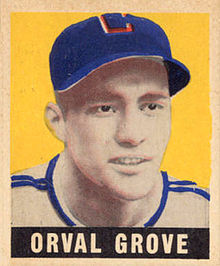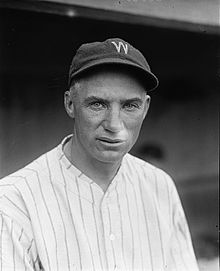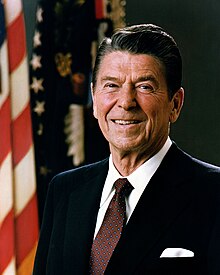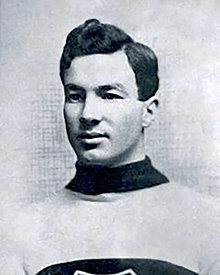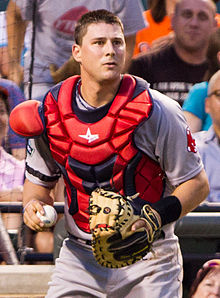Portal:Baseball
Portal maintenance status: (June 2018)
|
| Main page | Content, Categories & Topics | WikiProjects & Things you can do |
The Baseball Portal
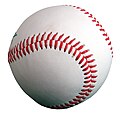
Baseball is a bat-and-ball sport played between two teams of nine players each, taking turns batting and fielding. The game occurs over the course of several plays, with each play generally beginning when a player on the fielding team, called the pitcher, throws a ball that a player on the batting team, called the batter, tries to hit with a bat. The objective of the offensive team (batting team) is to hit the ball into the field of play, away from the other team's players, allowing its players to run the bases, having them advance counter-clockwise around four bases to score what are called "runs". The objective of the defensive team (referred to as the fielding team) is to prevent batters from becoming runners, and to prevent runners' advance around the bases. A run is scored when a runner legally advances around the bases in order and touches home plate (the place where the player started as a batter).
The opposing teams switch back and forth between batting and fielding; the batting team's turn to bat is over once the fielding team records three outs. One turn batting for each team constitutes an inning. A game is usually composed of nine innings, and the team with the greater number of runs at the end of the game wins. Most games end after the ninth inning, but if scores are tied at that point, extra innings are usually played. Baseball has no game clock, though some competitions feature pace-of-play regulations such as the pitch clock to shorten game time.
Baseball evolved from older bat-and-ball games already being played in England by the mid-18th century. This game was brought by immigrants to North America, where the modern version developed. Baseball's American origins, as well as its reputation as a source of escapism during troubled points in American history such as the American Civil War and the Great Depression, have led the sport to receive the moniker of "America's Pastime"; since the late 19th century, it has been unofficially recognized as the national sport of the United States, though in modern times is considered less popular than other sports, such as American football. In addition to North America, baseball spread throughout the rest of the Americas and the Asia–Pacific in the 19th and 20th centuries, and is now considered the most popular sport in parts of Central and South America, the Caribbean, and East Asia, particularly in Japan, South Korea, and Taiwan. (Full article...)
 Featured articles - load new batch
Featured articles - load new batch
-
Image 1
Daniel Lucius "Doc" Adams (November 1, 1814 – January 3, 1899) was an American baseball player and executive who is regarded by historians as an important figure in the sport's early years. For most of his career he was a member of the New York Knickerbockers. He first played for the New York Base Ball Club in 1840 and started his Knickerbockers career five years later, continuing to play for the club into his forties and to take part in inter-squad practice games and matches against opposing teams. Researchers have called Adams the creator of the shortstop position, which he used to field short throws from outfielders. In addition to his playing career, Adams manufactured baseballs and oversaw bat production; he also occasionally acted as an umpire.
From 1847 to 1861, the Knickerbockers selected Adams as their president six times, and as a vice president, treasurer, or director in six other years. As president of the club, Adams was an advocate of rule changes in baseball that resulted in nine-man teams and nine-inning games. When the National Association of Base Ball Players (NABBP) was formed in 1858, he led the rules and regulations committee of the new organization. In his role, Adams ruled that the fields' bases should be 90 feet (27 m) apart, the modern distance, and supported the elimination of the "bound rule", which allowed for balls caught after one bounce to be recorded as outs. He resigned from his positions with the Knickerbockers and NABBP in 1862. Adams' contributions in creating baseball's rules went largely unrecognized for decades after his 1899 death, but in 1980 a letter about him appeared in The New York Times; by 1993, researcher John Thorn had written about Adams' role. Other historians have given him credit for helping to develop the sport, and Thorn has called Adams "first among the Fathers of Baseball". (Full article...) -
Image 2
Robert William Meusel (July 19, 1896 – November 28, 1977) was an American baseball left and right fielder who played in Major League Baseball (MLB) for eleven seasons from 1920 through 1930, all but the last for the New York Yankees. He was best known as a member of the Yankees' championship teams of the 1920s, nicknamed "Murderers' Row", during which time the team won its first six American League (AL) pennants and first three World Series titles.
Meusel, noted for his strong outfield throwing arm, batted fifth behind Baseball Hall of Famers Babe Ruth and Lou Gehrig. In 1925, he became the second Yankee, after Ruth, to lead the AL in home runs (33), runs batted in (138) and extra base hits (79). Nicknamed "Long Bob" because of his 6-foot, 3 inch (1.91 m) stature, Meusel batted .313 or better in seven of his first eight seasons, finishing with a .309 career average; his 1,009 RBI during the 1920s were the fourth most by any major leaguer, and trailed only Harry Heilmann's total of 1,131 among AL right-handed hitters. Meusel ended his career in 1930 with the Cincinnati Reds. He hit for the cycle three times, and was the second of six major leaguers to accomplish this feat as many as three times during a career. (Full article...) -
Image 3
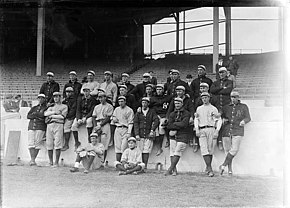
The 1913 squad, the first that went by the name "Yankees"
The history of the New York Yankees Major League Baseball (MLB) team spans more than a century. Frank J. Farrell and William Stephen Devery bought the rights to an American League (AL) club in New York City after the 1902 season. The team, which became known as the Yankees in 1913, rarely contended for the AL championship before the acquisition of outfielder Babe Ruth after the 1919 season. With Ruth in the lineup, the Yankees won their first AL title in 1921, followed by their first World Series championship in 1923. Ruth and first baseman Lou Gehrig were part of the team's Murderers' Row lineup, which led the Yankees to a then-AL record 110 wins and a Series championship in 1927 under Miller Huggins. They repeated as World Series winners in 1928, and their next title came under manager Joe McCarthy in 1932.
The Yankees won the World Series every year from 1936 to 1939 with a team that featured Gehrig and outfielder Joe DiMaggio, who recorded a record hitting streak during New York's 1941 championship season. New York set a major league record by winning five consecutive championships from 1949 to 1953, and appeared in the World Series nine times from 1955 to 1964. Mickey Mantle, Yogi Berra, and Whitey Ford were among the players fielded by the Yankees during the era. After the 1964 season, a lack of effective replacements for aging players caused the franchise to decline on the field, and the team became a money-loser for owners CBS while playing in an aging stadium. (Full article...) -
Image 4The Nashville Sounds Minor League Baseball team was established in Nashville, Tennessee, in 1978, after Larry Schmittou and a group of investors purchased the rights to operate an expansion franchise of the Double-A Southern League. The Sounds played their home games at Herschel Greer Stadium from its opening in 1978 until the end of the 2014 season. In 2015, the Sounds left Greer for First Tennessee Park, now known as First Horizon Park, a new facility located on the site of the historic Sulphur Dell ballpark, home to Nashville's minor league teams from 1885 to 1963.
The Sounds led all of Minor League Baseball in attendance in their inaugural season and continued to draw the Southern League's largest crowds in each of their seven years as members of the league. On the field, the team won six consecutive second-half division titles from 1979 to 1984 and won the Southern League championship twice: in 1979 as the Double-A affiliate of the Cincinnati Reds and again in 1982 as the Double-A affiliate of the New York Yankees. (Full article...) -
Image 5Disco Demolition Night was a Major League Baseball (MLB) promotion on Thursday, July 12, 1979, at Comiskey Park in Chicago, Illinois, that ended in a riot. At the climax of the event, a crate filled with disco records was blown up on the field between games of the twi-night doubleheader between the Chicago White Sox and the Detroit Tigers. Many had come to see the explosion rather than the games and rushed onto the field after the detonation. The playing field was so damaged by the explosion and by the rioters that the White Sox were required to forfeit the second game to the Tigers.
In the late 1970s, dance-oriented disco was the most popular music genre in the United States, particularly after being featured in hit films such as Saturday Night Fever (1977). However, disco sparked a major backlash from rock music fans—an opposition prominent enough that the White Sox, seeking to fill seats at Comiskey Park during a lackluster season, engaged Chicago shock jock and anti-disco campaigner Steve Dahl for the promotion at the July 12 doubleheader. Dahl's sponsoring radio station was WLUP (97.9 FM, now WCKL), so admission was discounted to 98 cents for attendees who turned in a disco record; between games, Dahl was to destroy the collected vinyl in an explosion. (Full article...) -
Image 6Advertisement in Billboard magazine in 1907
How Brown Saw the Baseball Game is an American short silent comedy film produced in 1907 and distributed by the Lubin Manufacturing Company. The film follows a baseball fan named Mr. Brown who overdrinks before a baseball game and becomes so intoxicated that the game appears to him in reverse motion. During production, trick photography was used to achieve this effect. The film was released in November 1907. It received a positive review in a 1908 issue of The Courier-Journal that reported the film was successful and "truly funny". As of 2021[update], it is unclear whether the print of the film has survived. The identities of the film cast and production crew are unknown. Film historians have noted similarities between the plot of How Brown Saw the Baseball Game and How the Office Boy Saw the Ball Game. It is a comedy film directed by Edwin S. Porter, having released a year before How Brown Saw the Baseball Game. (Full article...) -
Image 7
Orval Leroy Grove (August 29, 1919 – April 20, 1992) was an American professional baseball pitcher in Major League Baseball who played for ten seasons in the American League with the Chicago White Sox. In 207 career games, Grove pitched 1,176 innings and posted a win–loss record of 63–73, with 66 complete games, 11 shutouts, and a 3.78 earned run average (ERA).
The only freshman on the Proviso Township High School varsity baseball team, Grove's pitching ability attracted the attention of the White Sox. After signing with the team in 1937, Grove moved between the major leagues and minor leagues for a few seasons until 1943, when he found a solid place in the White Sox's pitching rotation. Grove had a career-year in 1943, finishing the season with career-bests in ERA, wins, and complete games; in 1944, he made his only All-Star appearance. (Full article...) -
Image 8

James Robert "Loafer" McAleer (July 10, 1864 – April 29, 1931) was an American center fielder, manager, and stockholder in Major League Baseball who assisted in establishing the American League. He spent most of his 13-season playing career with the Cleveland Spiders, and went on to manage the Cleveland Blues, St. Louis Browns, and Washington Senators. Shortly before his retirement, he became a major shareholder in the Boston Red Sox. His career ended abruptly. During his brief tenure as co-owner of the Red Sox, McAleer quarreled with longtime friend and colleague Ban Johnson, president of the American League. In the wake of this disagreement, he sold off his shares in the Red Sox and broke off his relationship with Major League Baseball.
McAleer's rift with Johnson, along with his sudden retirement, damaged his professional reputation, and he received little recognition for his contributions to baseball. Today, he is most often remembered for initiating the customary request that the President of the United States throw out the first ball of the season. (Full article...) -
Image 9
Robert William Andrew Feller (November 3, 1918 – December 15, 2010), nicknamed "the Heater from Van Meter", "Bullet Bob", and "Rapid Robert", was an American baseball pitcher who played 18 seasons in Major League Baseball (MLB) for the Cleveland Indians between 1936 and 1956. In a career spanning 570 games, Feller pitched 3,827 innings and posted a win–loss record of 266–162, with 279 complete games, 44 shutouts, and a 3.25 earned run average (ERA). His career 2,581 strikeouts were third all-time upon his retirement.
A prodigy who bypassed baseball's minor leagues, Feller made his debut with the Indians at the age of 17. His career was interrupted by four years of military service (1942–1945) as a United States Navy Chief Petty Officer aboard USS Alabama during World War II. Feller became the first pitcher to win 24 games in a season before the age of 21. He threw no-hitters in 1940, 1946, and 1951, and 12 one-hitters, both records at his retirement. He helped the Indians win a World Series title in 1948 and an American League-record 111 wins and the pennant in 1954. Feller led the American League in wins six times and in strikeouts seven times. In 1946 he recorded 348 strikeouts, the most since 1904 and then believed to be a record. (Full article...) -
Image 10
Stanley Anthony Coveleski (born Stanislaus Kowalewski, July 13, 1889 – March 20, 1984) was an American right-handed pitcher in Major League Baseball who played for four American League (AL) teams between 1912 and 1928, primarily the Cleveland Indians. The star of the Indians pitching staff, he won over 20 games each year from the war-shortened 1918 season through 1921, leading the AL in shutouts twice and in strikeouts and earned run average (ERA) once each during his nine years with the club. The star of the 1920 World Series, he led the Indians to their first title with three complete-game victories, including a 3–0 shutout in the Game 7 finale. Traded to the Washington Senators after the 1924 season, he helped that club to its second AL pennant in a row with 20 victories against only 5 losses, including a 13-game winning streak, while again leading the league in ERA.
Coveleski followed in the footsteps of his brother Harry as a major league pitcher. But after making his debut with the Philadelphia Athletics in 1912, he was sidetracked by three more seasons in the minor leagues before joining the Indians in 1916, and won only 13 major league games before turning 27. Coveleski specialized in throwing the spitball, where the pitcher alters the ball with a foreign substance such as chewing tobacco. It was legal when his career began but prohibited in 1920, with Coveleski being one of 17 pitchers permitted to continue throwing the pitch. In 450 career games, Coveleski pitched 3,082 innings and posted a record of 215–142, with 224 complete games, 38 shutouts, and a 2.89 ERA. He set Cleveland records of 172 wins, 2,502+1⁄3 innings and 305 starts, which were later broken by Mel Harder and Willis Hudlin. He was inducted into the Baseball Hall of Fame in 1969. (Full article...) -
Image 11
Ronald Wilson Reagan (February 6, 1911 – June 5, 2004) was an American politician and actor who served as the 40th president of the United States from 1981 to 1989. A member of the Republican Party, he became an important figure in the American conservative movement, and his presidency is known as the Reagan era.
Born and raised in Illinois, Reagan graduated from Eureka College in 1932 and was hired the next year as a sports broadcaster in Iowa. In 1937, he moved to California where he became a well-known film actor. During his acting career, Reagan was elected president of the Screen Actors Guild twice, serving from 1947 to 1952 and from 1959 to 1960. In the 1950s, he became the host for General Electric Theater and also worked as a motivational speaker for General Electric. Subsequently, Reagan's "A Time for Choosing" speech during the 1964 U.S. presidential election launched his rise as a leading conservative figure. After being elected governor of California in 1966, he raised the state taxes, turned the state budget deficit into a surplus and implemented harsh crackdowns on university protests. Following his loss to Gerald Ford in the 1976 Republican Party presidential primaries, Reagan won the Republican Party's nomination and then a landslide victory over President Jimmy Carter in the 1980 presidential election. (Full article...) -
Image 12Ross with the Montreal Wanderers, circa 1907–18
Arthur Howey Ross (January 13, 1885 – August 5, 1964) was a Canadian professional ice hockey player and executive from 1905 until 1954. Regarded as one of the best defenders of his era by his peers, he was one of the first to skate with the puck up the ice rather than pass it to a forward. He was on Stanley Cup championship teams twice in a playing career that lasted thirteen seasons; in January 1907 with the Kenora Thistles and 1908 with the Montreal Wanderers. Like other players of the time, Ross played for several different teams and leagues, and is noted for his time with the Wanderers while they were members of the National Hockey Association (NHA) and its successor, the National Hockey League (NHL). In 1911, he led one of the first organized player strikes over increased pay. When the Wanderers' home arena burned down in January 1918, the team ceased operations and Ross retired as a player.
After several years as an on-ice official, he was named head coach of the Hamilton Tigers for one season. When the Boston Bruins were formed in 1924, Ross was hired as the first coach and general manager of the team. He later coached the team on three separate occasions until 1945, and stayed as general manager until his retirement in 1954. Ross helped the Bruins finish first place in the league ten times and win the Stanley Cup three times; Ross personally coached the team to two of those victories. After being hired by the Bruins, Ross, along with his wife and two sons, moved to a suburb of Boston, and he became an American citizen in 1938. He died near Boston in 1964. (Full article...) -
Image 13

Depiction of the game from The Boston Globe
On Saturday, May 1, 1920, the Brooklyn Dodgers and the Boston Braves played to a 1–1 tie in 26 innings, the most innings ever played in a single game in the history of Major League Baseball (MLB). The game was played at Braves Field in Boston before a crowd estimated at 4,000. Both Leon Cadore of Brooklyn and Joe Oeschger of Boston pitched complete games, and with 26 innings pitched, jointly hold the record for the longest pitching appearance in MLB history. Their record is considered unbreakable, as modern pitchers rarely pitch even nine innings, and newer baseball rules have made long extra-innings games a rarity.
The day of the game saw rainy weather, and it was uncertain if the game would be played, but the skies cleared enough to allow it to proceed. Brooklyn scored a run in the fifth inning, and Boston in the sixth; thereafter, the pitchers became increasingly dominant. As the game exceeded eighteen innings, the small crowd at Braves Field cheered both pitchers. The last twenty innings were scoreless, and when darkness started to fall, the umpires called a halt after the twenty-sixth inning, as baseball fields did not yet have artificial lighting. (Full article...) -
Image 14Rogers Hornsby tags out Babe Ruth who is caught attempting to steal second base, ending the 1926 World Series.
The 1926 World Series was the championship series of the 1926 Major League Baseball season. The 23rd edition of the Series, it pitted the National League champion St. Louis Cardinals against the American League champion New York Yankees. The Cardinals defeated the Yankees four games to three in the best-of-seven series, which took place from October 2 to 10, 1926, at Yankee Stadium and Sportsman's Park.
This was the first World Series appearance (and first National League pennant win) for the Cardinals, and would be the first of 11 World Series championships in Cardinals history. The Yankees were playing in their fourth World Series in six years after winning their first American League pennant in 1921 and their first world championship in 1923. They would play in another 36 World Series (and win 26 of those), as of the end of the 2023 season. (Full article...) -
Image 15
Kenesaw Mountain Landis (/ˈkɛnɪsɔː ˈmaʊntɪn ˈlændɪs/; November 20, 1866 – November 25, 1944) was an American jurist who served as a United States federal judge from 1905 to 1922 and the first commissioner of baseball from 1920 until his death. He is remembered for his resolution of the Black Sox Scandal, in which he expelled eight members of the Chicago White Sox from organized baseball for conspiring to lose the 1919 World Series and repeatedly refused their reinstatement requests. His iron rule over baseball in the near quarter-century of his commissionership is generally credited with restoring public confidence in the game.
Landis was born in Millville, Ohio. Raised in Indiana, he became a lawyer, and then personal secretary to Walter Q. Gresham, the new United States Secretary of State, in 1893. He returned to private practice after Gresham died in office. (Full article...)
General images - load new batch
-
Image 1Sadaharu Oh managing the Japan national team in the 2006 World Baseball Classic. Playing for the Central League's Yomiuri Giants (1959–80), Oh set the professional world record for home runs with 868. (from History of baseball)
-
Image 2Cover of Official Base Ball Rules, 1921 edition, used by the American League and National League (from Baseball rules)
-
Image 3Baserunners generally stand a short distance away from their base between pitches, preparing themselves to either go back or steal the next base. (from Baseball rules)
-
Image 5Defensive positions on a baseball field, with abbreviations and scorekeeper's position numbers (not uniform numbers) (from Baseball)
-
Image 6The NL champion New York Giants baseball team, 1913. Fred Merkle, sixth in line, had committed a baserunning gaffe in a crucial 1908 game that became famous as Merkle's Boner. (from History of baseball)
-
Image 7Japanese-Americans spectating a World War II-era game while in an internment camp. America's ties to immigrants and to Japan have been deeply shaped by a shared baseball heritage. (from History of baseball)
-
Image 9Jackie Robinson in 1945, with the era's Kansas City Royals, a barnstorming squad associated with the Negro American League's Kansas City Monarchs (from History of baseball)
-
Image 10Alexander Cartwright, father of modern baseball (from History of baseball)
-
Image 11Pitchers are generally substituted during mound visits (team gatherings at the pitcher's mound). (from Baseball rules)
-
Image 12A New York Yankees batter (Andruw Jones) and a Boston Red Sox catcher at Fenway Park (from Baseball)
-
Image 13Pick-off attempt on runner (in red) at first base (from Baseball rules)
-
Image 14The strike zone, which determines the outcome of most pitches, varies in vertical length depending on the batter's typical height while swinging. (from Baseball rules)
-
Image 16By the 1860s Civil War, baseball (bottom) had overtaken its fellow bat-and-ball sport cricket (top) in popularity within the United States. (from History of baseball)
-
Image 17A game from the Cantigas de Santa Maria, c. 1280, involving tossing a ball, hitting it with a stick and competing with others to catch it (from History of baseball)
-
Image 182013 World Baseball Classic championship match between the Dominican Republic and Puerto Rico, March 20, 2013 (from Baseball)
-
Image 19Jackie Robinson in 1945, with the era's Kansas City Royals, a barnstorming squad associated with the Negro American League's Kansas City Monarchs (from Baseball)
-
Image 20A well-worn baseball (from Baseball)
-
Image 21A first baseman receives a pickoff throw, as the runner dives back to first base. (from Baseball)
-
Image 22The typical motion of a right-handed pitcher (from Baseball rules)
-
Image 23Fenway Park, home of the Boston Red Sox. The Green Monster is visible beyond the playing field on the left. (from Baseball)
-
Image 24A pitcher handing off the ball after being taken out of the game during a mound meeting. (from Baseball)
-
Image 251906 World Series, infielders playing "in" for the expected bunt and the possible play at the plate with the bases loaded (from Baseball rules)
-
Image 26Pesäpallo, a Finnish variation of baseball, was invented by Lauri "Tahko" Pihkala in the 1920s, and after that, it has changed with the times and grown in popularity. Picture of Pesäpallo match in 1958 in Jyväskylä, Finland. (from Baseball)
-
Image 27Cy Young—the holder of many major league career marks, including wins and innings pitched, as well as losses—in 1908. MLB's annual awards for the best pitcher in each league are named for Young. (from Baseball)
-
Image 29Diagram of a baseball field Diamond may refer to the square area defined by the four bases or to the entire playing field. The dimensions given are for professional and professional-style games. Children often play on smaller fields. (from Baseball)
-
Image 31Baseball games sometimes end in a walk-off home run, with the batting team usually gathering at home plate to celebrate the scoring of the winning run(s). (from Baseball rules)
-
Image 32The American Tobacco Company's line of baseball cards featured shortstop Honus Wagner of the Pittsburgh Pirates from 1909 to 1911. In 2007, the card shown here sold for $2.8 million. (from Baseball)
-
Image 34A runner sliding into home plate and scoring. (from Baseball)
-
Image 36The strike zone determines the result of most pitches, and varies in vertical length for each batter. (from Baseball)
-
Image 38Rickey Henderson—the major leagues' all-time leader in runs and stolen bases—stealing third base in a 1988 game (from Baseball)
-
Image 39Two players on the baseball team of Tokyo, Japan's Waseda University in 1921 (from Baseball)
-
Image 40The standard fielding positions (from Baseball rules)
-
Image 41An Afghan girl playing baseball in August 2002 (from Baseball)
-
Image 43A batter follows through after swinging at a pitched ball. (from Baseball rules)
-
Image 44Sadaharu Oh managing the Japan national team in the 2006 World Baseball Classic. Playing for the Central League's Yomiuri Giants (1959–80), Oh set the professional world record for home runs. (from Baseball)
-
Image 45In May 2010, the Philadelphia Phillies' Roy Halladay pitched the 20th major league perfect game. That October, he pitched only the second no-hitter in MLB postseason history. (from History of baseball)
 Good articles - load new batch
Good articles - load new batch
-
Image 1
Richard Edward Donovan (December 7, 1927 – January 6, 1997) was an American Major League Baseball pitcher who played for the Boston Braves (1950–1952), Detroit Tigers (1954), Chicago White Sox (1955–1960), Washington Senators (1961) and Cleveland Indians (1962–1965). He batted left-handed and threw right-handed, stood 6 feet 3 inches (1.91 m) tall and weighed 190 pounds (86 kg).
A Boston native, Donovan graduated from North Quincy High School and served in the United States Navy during and after World War II. Signed by the hometown Braves, he reached the major leagues in 1950 but was used sporadically over the next several years. While pitching for the minor league Atlanta Crackers, he learned how to throw a slider, and this helped him claim a spot in the White Sox' rotation in 1955. He was an All-Star in his first major league season, winning 15 games with only nine losses. In 1956, he led the American League (AL) with a 1.155 walks plus hits per innings pitched. He led the AL with a .727 winning percentage in 1957, going 16–6, and he won 15 games for the White Sox in 1958. He pitched in the 1959 World Series against the Los Angeles Dodgers, losing Game 3 but earning the save in Game 5. Donovan struggled in 1960 and was moved to the bullpen, then got selected in the expansion draft by the Senators after the season. He had his best year with the new club in 1961, leading the AL with a 2.40 earned run average (ERA), though his won-loss record was just 10–10. Traded to the Indians for Jimmy Piersall after the season, he won 20 games his first year with Cleveland. Donovan pitched three more years for the Indians after that before getting released midway through 1965. Following his baseball career, he sold insurance and held other jobs in the Quincy, Massachusetts area before dying of cancer in 1997. (Full article...) -
Image 2
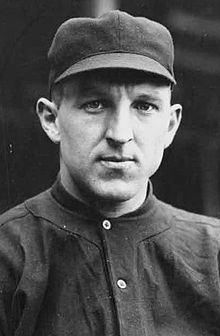
Charles Lincoln "Buck" Herzog (July 9, 1885 – September 4, 1953) was an American infielder and manager in Major League Baseball who played for four National League clubs between 1908 and 1920: the New York Giants, the Boston Braves, the Cincinnati Reds, and the Chicago Cubs. His flexibility sets him apart from other major leaguers, as he demonstrated great skill as a second baseman, shortstop, and third baseman.
Born in Baltimore, Maryland, Herzog grew up on a farm in nearby Ridgely. After attending the Maryland Agricultural College, he played one season in the minor leagues before the Giants selected him in the Rule 5 Draft. Herzog batted .300 as a rookie but struggled in 1909 and was traded to Boston before 1910. He cemented himself as an everyday player over the next two years, then was reacquired by the Giants in 1911, with whom he would reach three straight World Series. He struggled to hit in the 1911 World Series but set a record that would stand for over 50 years with 12 hits in the 1912 World Series, though the Giants lost all three of the series. Traded to the Reds before the 1914 season, he served as a player-manager for the Reds through the first half of the 1916 season, though the team had a losing record in each of those years. The Giants reacquired him halfway through 1916, naming him the team captain. After a famous fight with Ty Cobb during 1917 spring training, he played in his fourth and final World Series, though he made a key error in Game 5 as the Giants were defeated in six games. Herzog spent 1918 with Boston, was traded to Chicago in the middle of 1919, and played one last year with the Cubs in 1920, a season that saw his reputation tarnished by unsubstantiated accusations of gambling on baseball games. (Full article...) -
Image 3
José Alberto Pujols Alcántara (Spanish pronunciation: [puˈxols], Catalan pronunciation: [puˈʒɔls]; born January 16, 1980) is a Dominican-American professional baseball manager and former first baseman and designated hitter who is the manager of the Leones del Escogido of the Dominican Professional Baseball League. He played 22 seasons in Major League Baseball (MLB) for the St. Louis Cardinals, Los Angeles Angels of Anaheim / Los Angeles Angels, and Los Angeles Dodgers. Nicknamed "the Machine" (Spanish: La Máquina), Pujols is considered to be one of the greatest baseball players of all time.
Pujols is a highly regarded hitter who has long shown a "combination of contact hitting ability, patience and raw power." He was the National League (NL) Most Valuable Player (MVP) in 2005, 2008, and 2009 and is an 11-time All-Star (2001, 2003–2010, 2015, 2022). He is a six-time Silver Slugger who has twice led the NL in home runs, and he has also led the NL once each in batting average, doubles, and runs batted in (RBIs). In 2018, Pujols collected his 3,000th career hit, becoming the 32nd MLB player to reach that milestone. During the 2022 season, Pujols returned to the Cardinals and moved into second place all-time for career RBIs and total bases and became the fourth player with 700 career home runs. At the end of the season, he was also the major league career leader in double plays grounded into (426), 3rd in sacrifice flies (123), 5th in games played (3,080) and doubles (686), and 6th in at bats (11,421). He won two Gold Glove awards at first base in his career. (Full article...) -
Image 4Jews have been involved in baseball since the sport's beginnings in the mid-19th century and have contributed to its evolution in many capacities, including players, agents, team owners, executives, umpires, broadcasters, and fans. In the United States, particularly, baseball played a large part in the assimilation of American Jews into American society at a time of rampant antisemitism and when Jews were immigrating to America to escape persecution. Today, it remains a very important part in Jewish American culture.
On the field, Jewish baseball players faced constant antisemitic heckles from opponents and fans, with many hiding their heritage to avoid discrimination in the league. Despite this, a number of Jewish players overcame such abuse and went on to become stars. Two such players, Hank Greenberg and Sandy Koufax, were both elected to the Baseball Hall of Fame and are widely considered to be amongst the most important and iconic players in baseball history. Similarly, off the field, Jews were involved deeply in the evolution of the game with executive Barney Dreyfuss, a Jewish immigrant who responsible for the founding of the World Series, the most prestigious event in baseball, and Marvin Miller who revolutionized the relationship between players and owners by unionizing players and helping usher in the era of free agency. (Full article...) -
Image 5
On September 30, 1984, Mike Witt of the California Angels threw a perfect game against the Texas Rangers at Arlington Stadium. It was the 11th perfect game in Major League Baseball (MLB) history. Witt threw 94 pitches, struck out 10 of the 27 batters he faced, and had a game score of 97.
Witt's perfect game occurred on the final day of the 1984 MLB season. Both the Angels and Rangers had already been eliminated from playoff contention, and as a result, a small crowd of 8,375 people attended the game. The opposing pitcher was Charlie Hough, who threw a complete game and allowed one unearned run. Of the 27 batters Witt faced, only a few threatened to reach base. Larry Parrish hit a ground ball that forced third baseman Doug DeCinces to make a barehanded throw in the fifth inning. Parrish also hit a long fly out in the eighth inning that Witt initially assumed was going to be a home run. (Full article...) -
Image 6
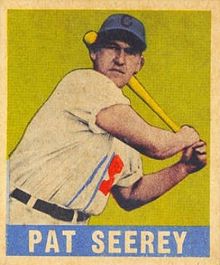
James Patrick Seerey (March 17, 1923 – April 28, 1986) was an American professional baseball player. An outfielder, Seerey played in Major League Baseball (MLB) for seven seasons in the American League with the Cleveland Indians and Chicago White Sox. In 561 career games, Seerey recorded a batting average of .224 and accumulated 86 home runs and 261 runs batted in (RBI).
Born in Oklahoma and raised in Arkansas, Seerey played football and baseball in high school. After graduating, he joined the Cleveland Indians' farm system in 1941, and made his major league debut two-and-a-half years later. He was primarily a starting outfielder the next five seasons for the Indians, but led the league in strikeouts four times. He was traded partway through the 1948 season to the Chicago White Sox, and a month after being traded became the fifth player in major league history to hit four home runs in one game. The following season, he was sent to the minor leagues, and played a few seasons in the farm system for the White Sox before retiring. (Full article...) -
Image 7
Calvin Edwin Ripken Jr. (born August 24, 1960), nicknamed "the Iron Man", is an American former baseball shortstop and third baseman who played his entire 21-season career in Major League Baseball (MLB) for the Baltimore Orioles (1981–2001). One of his position's most productive offensive players, Ripken compiled 3,184 hits, 431 home runs, and 1,695 runs batted in during his career, and he won two Gold Glove Awards for his defense. He was a 19-time All-Star and was twice named American League (AL) Most Valuable Player (MVP), in 1983 and 1991. Ripken holds the record for consecutive games played (2,632), having surpassed Lou Gehrig's streak of 2,130 which had stood for 56 years and which many deemed was unbreakable. In 2007, he was elected to the Baseball Hall of Fame in his first year of eligibility with 98.53% of votes, the sixth-highest election percentage ever to-date.
Born in Maryland, Ripken grew up traveling around the United States as his father, Cal Sr., was a player and coach in the Orioles' organization. After playing at Aberdeen High School, Ripken Jr. was drafted by the Orioles in the second round of the 1978 MLB draft. He reached the major leagues in 1981 as a shortstop but moved to third base in 1982, but the following year, he was shifted back to shortstop, his long-time position for Baltimore. That year, Ripken also won the AL Rookie of the Year Award and began his consecutive games played streak. In 1983, he won a World Series championship over the Philadelphia Phillies and his first AL MVP Award. One of Ripken's best years came in 1991 when he was named an All-Star, won the Home Run Derby, and was the recipient of his first All-Star Game MVP Award, his second AL MVP Award, and first Gold Glove Award. He broke the consecutive games played record on September 6, 1995, in his 2,131st consecutive game, which fans voted as the league's "most memorable moment" in the history of the game in an MLB.com poll; Ripken voluntarily ended his 17-year streak at 2,632 games before the final home game of the 1998 season. He switched back to third base for the final five years of his career. In 2001, his final season, Ripken was named the All-Star Game MVP and was honored with the Commissioner's Historic Achievement Award. (Full article...) -
Image 8
Russell Jay Kuntz (/ˈkuːnts/ KOONTS; born February 4, 1955) is an American baseball coach and former Major League Baseball (MLB) outfielder. He played for the Chicago White Sox, Minnesota Twins and Detroit Tigers between 1979 and 1985. He never appeared in more than 84 games in any season during his playing career. In the final game of the 1984 World Series, Kuntz hit a pop fly to the second baseman that became the deciding run batted in (RBI).
Kuntz grew up in Kansas and California, playing three sports in high school and community college. He went to the Division III World Series twice with California State University, Stanislaus before being selected by the White Sox in the 11th round of the 1977 Major League Baseball draft. (Full article...) -
Image 9

The short right field fence at the Polo Grounds
Chinese home run, also a Chinese homer, Harlem home run, Polo home run, or Pekinese poke, is a derogatory and archaic baseball term for a hit that just barely clears the outfield fence at its closest distance to home plate. It is essentially the shortest home run possible in the ballpark in question, particularly if the park has an atypically short fence. The term was most commonly used in reference to home runs hit along the right field foul line at the Polo Grounds, home of the New York Giants, where that distance was short even by contemporary standards. When the Giants moved to San Francisco in 1958, the Los Angeles Coliseum, temporary home of the newly relocated Los Angeles Dodgers, gained the same reputation for four seasons until the team took up residence in its permanent home at Dodger Stadium in 1962. Following two seasons of use by the expansion New York Mets in the early 1960s, the Polo Grounds were demolished, and the term gradually dropped out of use.
Why these home runs were called "Chinese" is not definitely known, but it is believed to have reflected an early 20th-century perception that Chinese immigrants to the United States did the menial labor they were consigned to with a bare minimum of adequacy, and were content with minimal reward for it. A Tad Dorgan cartoon has been proposed as the likely origin, but that has not been proven; the earliest known usages are in a 1927 newspaper account of a Pittsburgh Pirates–Philadelphia Phillies major-league game, and in a 1919 newspaper account of a Los Angeles Angels–Sacramento Senators minor-league game. In the 1950s, an extended take on the term in the New York Daily News led the city's Chinese-American community to ask sportswriters not to use it. This perception of ethnic insensitivity has further contributed to its disuse. (Full article...) -
Image 10Cross Game (Japanese: クロスゲーム, Hepburn: Kurosu Gēmu) is a Japanese baseball-themed manga series written and illustrated by Mitsuru Adachi. It was serialized in Shogakukan shōnen manga magazine Weekly Shōnen Sunday from April 2005 to February 2010, with its chapters collected in 17 tankōbon volumes. The series was adapted as a 50-episode anime television series that aired on the TV Tokyo network from April 2009 to March 2010.
Cross Game is the story of Ko Kitamura and the four neighboring Tsukishima sisters, Ichiyo, Wakaba, Aoba, and Momiji. Wakaba and Ko were born on the same day in the same hospital and are close enough that Wakaba treats Ko as her boyfriend, though nothing is officially declared, while Aoba, one year younger than them, hates how Ko is "taking" her sister away from her. After Wakaba dies in an accident, Ko and Aoba slowly grow closer as they strive to fulfill Wakaba's final dream of seeing them play in the high school baseball championship in Koshien Stadium. The manga is divided into multiple parts. Part One, which consists of volume one, is a prologue that takes place while the main characters are in elementary school, ending in tragedy. Part Two starts four years later with Ko in his third year of junior high and continues into the summer of his third year of high school. Part Three continues the story without a break, ending with Ko and Aoba traveling to Koshien. (Full article...) -
Image 11The 2014 National League Wild Card Game was a play-in game during Major League Baseball's (MLB) 2014 postseason played between the National League's (NL) two wild card teams, the San Francisco Giants and the Pittsburgh Pirates. It was held at PNC Park in Pittsburgh, Pennsylvania, on October 1, 2014, starting at 8:07 p.m. EDT. After both teams finished the regular season with identical records of 88–74, the Pirates were awarded home field for the game, as they won the season series against the Giants, 4–2. Despite this advantage, the Giants won by a score of 8–0 and advanced to play the Washington Nationals in the NL Division Series. In addition to being the third NL Wild Card Game played, it is notable for the first postseason grand slam hit by a shortstop. The game was televised on ESPN, and was also broadcast on ESPN Radio. (Full article...)
-
Image 12
Matthew Thomas Cain (born October 1, 1984) is an American former professional baseball pitcher who played his entire Major League Baseball (MLB) career for the San Francisco Giants from 2005 to 2017. A three-time World Series champion and a three-time National League All-Star, he is widely regarded as a central figure of the Giants' success in the 2010s for his pitching and leadership.
The Giants drafted Cain out of high school in 2002, and he made his MLB debut at age 20 in 2005, becoming the youngest player in the National League (NL) that year. In 2009, Cain was named to his first career All-Star Game and won the Willie Mac Award. During the 2010 MLB postseason, he did not allow an earned run in any of the three playoff games he pitched in as the Giants won their first World Series since 1954. In 2012, Cain signed a contract extension that, at the time, gave him the most lucrative contract ever received by a right-handed pitcher in major league history. Cain threw the 22nd perfect game in big league history on June 13, 2012. He had a 16–5 record during the 2012 regular season, finishing sixth in NL Cy Young Award voting. During the Giants' playoff run that led to their victory in the 2012 World Series, the team won every series-clinching playoff game that Cain started. Cain ended his pitching career in 2017. (Full article...) -
Image 13
Ryan Cole Lavarnway (Hebrew: ריאן לווארנוויי; born August 7, 1987) is an American-Israeli former professional baseball catcher. He played in Major League Baseball (MLB) for the Boston Red Sox, Baltimore Orioles, Atlanta Braves, Oakland Athletics, Pittsburgh Pirates, Cincinnati Reds, Miami Marlins, and Cleveland Indians. In international competition, he plays for Team Israel, and competed for them in the World Baseball Classic and in the Olympics.
Lavarnway attended Yale University, where in 2007 he won the National Collegiate Athletic Association (NCAA) batting title by hitting .467 and led the NCAA with an .873 slugging percentage. That year, Lavarnway also set the Ivy League record with a 25-game hitting streak. In addition, he set the Ivy League all-time career home run record, with 33. (Full article...) -
Image 14Alva Lee Holloman (March 7, 1923 – May 1, 1987), nicknamed "Bobo", was an American right-handed pitcher in Major League Baseball (MLB), who played in one season with the American League (AL) St. Louis Browns, in 1953. In 22 career games, he pitched 65+1⁄3 innings and posted a win–loss record of 3–7, with a 5.23 earned run average (ERA).
Born in Thomaston, Georgia, Holloman served in World War II before starting his professional baseball career. From 1946 to 1952, he gradually rose up through the minor leagues, and got a spring training invitation from the Chicago Cubs in 1950. (Full article...) -
Image 15
Martin Bergen (October 25, 1871 – January 19, 1900) was an American professional baseball player. From 1896 to 1899 he played in 344 games with the Boston Beaneaters of Major League Baseball (MLB), 337 of them as their catcher. Bergen helped the Beaneaters to National League pennants in 1897 and 1898, as well as a second-place finish in 1899.
Bergen appeared to have a mental illness. By 1899, he experienced hallucinations, had to be removed from a game due to odd behavior, and walked off from the team train during a trip to Boston. On January 19, 1900, he killed his wife and two children before dying by suicide. (Full article...)
Did you know (auto-generated) - load new batch

- ... that Cam Booser retired from baseball to work as a carpenter in 2017 and made it to Major League Baseball in 2024?
- ... that Kelsie Whitmore was part of the first all-female battery in a professional baseball league since the All-American Girls Professional Baseball League?
- ... that baseball player Dwight Smith recorded a demo rhythm and blues album during the 1993–94 offseason?
- ... that Major League Baseball set a single-day record with $1.4 billion in new player contracts the day before the 2021 lockout was set to begin?
- ... that Drew Golz, who was Baseball Academic All-American of the Year and Soccer Academic All-American of the Year, became the first male student athlete to be named Academic All-American of the year for two sports at the same time?
- ... that Tom Urbani was an original Dirtbag?
- ... that Brewer Hicklen hosts an annual youth baseball camp in Alabama?
- ... that thirty years after playing his first season for the Miami Hurricanes, J. D. Arteaga became the team's head coach in 2024?
Quotes
| "The only way to make money as a manager is to win in one place, get fired and hired somewhere else." |
 Featured lists - load new batch
Featured lists - load new batch
-
Image 1

Bill Dawley was the starting pitcher for the Sounds' inaugural April 15, 1978, opener.
The Nashville Sounds Minor League Baseball team has played in Nashville, Tennessee, since being established in 1978 as an expansion team of the Double-A Southern League. They moved up to Triple-A in 1985 as members of the American Association before joining the Pacific Coast League in 1998. With the restructuring of the minor leagues in 2021, they were placed in the Triple-A East, which became the International League in 2022. The first game of the new baseball season for a team is played on Opening Day, and being named the Opening Day starting pitcher is an honor which is given to the player who is expected to lead the pitching staff that season, though there are various strategic reasons why a team's best pitcher might not start on Opening Day. The Sounds have used 43 different Opening Day starters in their 46 seasons.
Nashville's first Opening Day game was played against the Memphis Chicks at Tim McCarver Stadium in Memphis, Tennessee, on April 15, 1978. Bill Dawley was their starting pitcher that day; he took the decision in a game the Sounds lost, 4–2. Their first Opening Day game held at home was an 8–7 win against the Birmingham Barons at Herschel Greer Stadium on April 9, 1981. Starter Jamie Werly, who went on to win the Southern League Most Outstanding Pitcher Award that season, did not figure in the decision. On April 4, 2013, starter Tyler Thornburg took a no decision in the final Opening Day game at Greer Stadium, a 5–4 Sounds win. The team left Greer after the 2014 season, but did not play their first Opening Day game at First Horizon Park, their new facility then known as First Tennessee Park, until two years later. In that game, held on April 7, 2016, Sounds starting pitcher Chris Smith was charged with the loss in a 5–0 shutout by the Oklahoma City Dodgers. (Full article...) -
Image 2
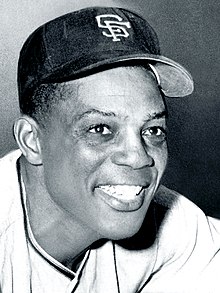
Willie Mays is tied with Roberto Clemente for the most Gold Gloves won by an outfielder, with 12 awards each.
The Rawlings Gold Glove Award, usually referred to as the Gold Glove, is the award given annually to the Major League Baseball players judged to have exhibited superior individual fielding performances at each fielding position in both the National League (NL) and the American League (AL), as voted by the managers and coaches in each league. Managers are not permitted to vote for their own players. Twenty-two Gold Gloves are awarded each year (with the exception of 1957, 1985, 2007 and 2018), one at each of the nine positions, one for a utility player, and one for a team as a whole, in each respective league. In 1957, the baseball glove manufacturer Rawlings created the Gold Glove Award to commemorate the best fielding performance at each position. The award was created from a glove made from gold lamé-tanned leather and affixed to a walnut base. Initially, only one Gold Glove per position was awarded to the top fielder at each position in the entire major league; however, separate awards were given for the National and American Leagues beginning in 1958.
The phrase "at each position" was not strictly accurate until 2011, when the awards were changed to specify individual awards for left fielder, center fielder, and right fielder. Previously, the prize was presented to three outfielders irrespective of their specific position. Any combination of outfielders, often three center fielders, could win the award in the same year. Critics called for awarding a single Gold Glove for each individual outfield position, arguing that the three outfield positions are not equivalent defensively. In the 1985 American League voting, a tie for third-place resulted in the presentation of Gold Glove Awards to four outfielders (Dwayne Murphy, Gary Pettis, Dwight Evans and Dave Winfield); this scenario was repeated in the National League in 2007 (Andruw Jones, Carlos Beltrán, Aaron Rowand, and Jeff Francoeur). Father and son Bobby and Barry Bonds are the only family pair who have won Gold Glove Awards as outfielders. (Full article...) -
Image 3The Chicago White Sox is a U.S. professional baseball team based in Chicago, Illinois. The White Sox are members of the American League Central Division in Major League Baseball. In baseball, the head coach of a team is called the manager, or more formally, the field manager. The duties of the team manager include team strategy and leadership on and off the field. Since the inception of the team in 1901, it has employed 41 different managers. The team's most recent manager was Pedro Grifol. Grifol was hired on November 3, 2022. Grifol was fired on August 8th, 2024.
Grifol replaced Tony La Russa, who was re-hired on October 29, 2020. La Russa's first managerial stint with the team lasted from 1979 to 1986. (Full article...) -
Image 4

Walter Johnson holds the record with 12 different seasons that he was a strikeout leader, including 8 consecutive from 1912 through 1919. Johnson was one of the five charter members of the Baseball Hall of Fame.
In baseball, the strikeout is a statistic used to evaluate pitchers. A pitcher earns a strikeout when he puts out the batter he is facing by throwing a ball through the strike zone, "defined as that area over homeplate (sic) the upper limit of which is a horizontal line at the midpoint between the top of the shoulders and the top of the uniform pants, and the lower level is a line at the hollow beneath the kneecap", which is not put in play. Strikeouts are awarded in four situations: if the batter is put out on a third strike caught by the catcher (to "strike out swinging" or "strike out looking"); if the pitcher throws a third strike which is not caught with fewer than two outs; if the batter becomes a baserunner on an uncaught third strike; or if the batter bunts the ball into foul territory with two strikes.
Major League Baseball recognizes the player or players in each league[a] with the most strikeouts each season. Jim Devlin led the National League in its inaugural season of 1876; he threw 122 strikeouts for the Louisville Grays. The American League's first winner was Hall of Fame pitcher Cy Young, who captured the American League Triple Crown in 1901 by striking out 158 batters, along with leading the league in wins and earned run average. Walter Johnson led the American League in strikeouts twelve times during his Hall of Fame career, most among all players. He is followed by Nolan Ryan, who captured eleven titles between both leagues (nine in the American League and two in the National League). Randy Johnson won nine strikeout titles, five coming with the Arizona Diamondbacks. Three players have won seven strikeout championships: Dazzy Vance, who leads the National League; Bob Feller; and Lefty Grove. Grover Cleveland Alexander and Rube Waddell led their league six times, and five-time winners include Steve Carlton, Roger Clemens, Sam McDowell, Christy Mathewson, Amos Rusie, and Tom Seaver. (Full article...) -
Image 5

Ken Griffey Jr. was the first pick overall in the 1987 draft, a 13-time All-Star selection during his career, and a first-ballot Hall of Fame inductee in 2016.
The Seattle Mariners are a Major League Baseball (MLB) franchise based in Seattle, Washington. They play in the American League West division. Since the franchise entered the league as an expansion team in 1977, they have selected 47 players in the first round. Officially known as the "First-Year Player Draft", the Rule 4 Draft is Major League Baseball's primary mechanism for assigning amateur baseball players from high schools, colleges, and other amateur baseball clubs to its teams. The draft order is determined based on the previous season's standings, with the team possessing the worst record receiving the first pick. In addition, teams that lost free agents in the previous off-season may be awarded compensatory or supplementary picks. The First-Year Player Draft is unrelated to the 1976 expansion draft through which the Mariners filled their roster.
Of the 47 players selected in the first round by the Mariners, 18 have been pitchers, the most of any position; of whom 13 were right-handed and five left-handed. They have also drafted nine outfielders, eight shortstops, seven catchers, three first basemen and two third baseman. Seattle has never drafted a second baseman in the first round. The Mariners have drafted 22 players out of high school, and 24 out of college. All of the college selections came from four-year institutions; the team has never selected a junior college player in the first round. The Mariners have drafted 11 players from high schools or colleges in California, four players from Florida, and a single player from their home state of Washington. One of the Mariners' 2007 picks—Canadian Phillippe Aumont—is the only selection from outside the United States. (Full article...) -
Image 6

Cole Hamels, the Phillies' first-round pick in 2002
The Philadelphia Phillies are a Major League Baseball franchise based in Philadelphia, Pennsylvania. They play in the National League East division. Since the institution of Major League Baseball's Rule 4 Draft, the Phillies have selected 51 players in its first round. Officially known as the "First-Year Player Draft", the Rule 4 Draft is Major League Baseball's primary mechanism for assigning amateur baseball players from high schools, colleges, and other amateur baseball clubs to its teams. The draft order is determined based on the previous season's standings, with the team possessing the worst record receiving the first pick. In addition, teams which lost free agents in the previous off-season may be awarded compensatory or supplementary picks.
Of the 51 players picked in the first round by the Phillies, 26 have been pitchers, the most of any position; 20 of these were right-handed, while 6 were left-handed. Nine players picked in the initial round were outfielders, while six catchers, four first basemen, and four shortstops were selected. The team also selected one player each at second base and third base. Thirteen of the 45 players came from high schools or universities in the state of California, while Texas and Florida follow, with six and five players, respectively. (Full article...) -
Image 7

The Philadelphia Phillies won their second consecutive pennant in 2009 and lost to the San Francisco Giants in the 2010 NLCS.
The National League pennant winner of a given Major League Baseball season is the team that wins the championship—the pennant—of MLB's National League (NL). This team receives the Warren C. Giles Trophy and the right to play in the World Series against the champion of the American League (AL). The current NL pennant winners are the Los Angeles Dodgers, who beat out the New York Mets to win the NL pennant in October 2024.
The trophy is named for Warren Giles, the league president from 1951 to 1969, and is presented immediately after each NL Championship Series (NLCS) by Warren's son Bill Giles, the honorary league president and former owner of the Philadelphia Phillies. (Full article...) -
Image 8

Bobby Lowe was the first MLB player to hit four home runs in a single game, doing so in 1894.
In baseball, a home run occurs when the ball is hit in such a way that the batter is able to circle the bases and reach home safely in one play without any errors being committed by the defensive team in the process. In modern baseball, the feat is typically achieved by hitting the ball over the outfield fence between the foul poles (or making contact with either foul pole) without first touching the ground, resulting in an automatic home run. There is also the "inside-the-park" home run where the batter reaches home safely while the baseball is in play on the field.
Eighteen players have hit four home runs in a single Major League Baseball (MLB) game, which writers of Sporting News described as "baseball's greatest single-game accomplishment". The most recent to accomplish the feat to date is J. D. Martinez with the Arizona Diamondbacks against the Los Angeles Dodgers on September 4, 2017. No player has done this more than once in his career. In the pre-professional era, Lipman Pike also hit five home runs in 1866. No player has ever hit four home runs in a postseason game; that record is three, first accomplished by Babe Ruth in Game 4 of the 1926 World Series. (Full article...) -
Image 9The Marvin Miller Man of the Year Award is given annually to a Major League Baseball (MLB) player "whose on-field performance and contributions to his community inspire others to higher levels of achievement." The award was created by the Major League Baseball Players' Association (MLBPA) and was presented to the inaugural winner – Mark McGwire – in 1997 as the "Man of the Year Award". Three years later, it was renamed in honor of Marvin Miller, the first executive director of the MLBPA. The award forms part of the Players Choice Awards.
In order to determine the winner, each MLB team nominates one of their players, who is selected by their teammates to appear on the ballot. An online vote is conducted among baseball fans in order to reduce the number of candidates to six. MLB players then choose the award winner from among the six finalists. In addition to the award, recipients have $50,000 donated on their behalf to charities of their choice by the MLB Players Trust. John Smoltz, Jim Thome, Michael Young, Curtis Granderson, and Marcus Semien are the only players to win the Marvin Miller Man of the Year Award on multiple occasions. Five winners – Paul Molitor, Jim Thome, Smoltz, Chipper Jones and Mariano Rivera – are members of the National Baseball Hall of Fame. (Full article...) -
Image 10
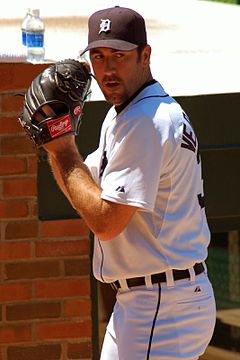
Justin Verlander (2004) is the only first-round pick of the Detroit Tigers to win the Rookie of the Year award.
The Detroit Tigers are a Major League Baseball (MLB) franchise based in Detroit, Michigan. They play in the American League Central division. Since the institution of MLB's Rule 4 Draft, the Tigers have selected 66 players in the first round. Officially known as the "First-Year Player Draft", the Rule 4 Draft is MLB's primary mechanism for assigning players from high schools, colleges, and other amateur clubs to its franchises. The draft order is determined based on the previous season's standings, with the team possessing the worst record receiving the first pick. In addition, teams which lost free agents in the previous off-season may be awarded compensatory or supplementary picks.
Of the 66 players picked in the first round by Detroit, 32 have been pitchers, the most of any position; 25 of these were right-handed, while five were left-handed. Thirteen outfielders were selected, while five shortstops, five catchers, four third basemen, three first basemen, and two second baseman were taken as well. One additional player, Lance Parrish (1974), was drafted as an infielder but ultimately spent the majority of his Major League career at catcher. Thirteen of the players came from high schools or universities in the state of California, followed by Texas with ten players. The Tigers have also drafted five players from their home state of Michigan. (Full article...) -
Image 11The Roberto Clemente Award is given annually to the Major League Baseball (MLB) player who "best exemplifies the game of baseball, sportsmanship, community involvement and the individual's contribution to his team", as voted on by baseball fans and members of the media. It is named for Hall of Fame outfielder Roberto Clemente. Originally known as the Commissioner's Award, it has been presented by MLB since 1971. In 1973, the award was renamed after Clemente following his death in a plane crash while he was delivering supplies to victims of the Nicaragua earthquake.
Each year, a panel of baseball dignitaries selects one player from among 30 nominees, one from each club. Teams choose their nominee during the regular season, and the winner is announced before Game 3 of the World Series. The player who receives the most votes online via MLB's official website, MLB.com, gets one vote in addition to the votes cast by the panel. Since 2007, the Roberto Clemente Award has been presented by Chevy. Chevy donates money and a Chevy vehicle to the recipient's charity of choice and additional money is donated by Chevy to the Roberto Clemente Sports City, a non-profit organization in Carolina, Puerto Rico, that provides national sports activities for children. Chevy donates additional funds to the charity of choice of each of the 30 club nominees. (Full article...) -
Image 12

Roy Oswalt, the Houston Astros Opening Day starting pitcher for eight straight years, from 2003 through 2010.
The Houston Astros are a Major League Baseball (MLB) franchise based in Houston, Texas. They currently play in the American League West division. The first game of the new baseball season for a team is played on Opening Day, and being named the Opening Day starter is an honor, which is often given to the player who is expected to lead the pitching staff that season, though there are various strategic reasons why a team's best pitcher might not start on Opening Day.
The Astros began to play in 1962 as the Houston Colt .45s (their name was changed to the Astros in 1965 when the Houston Astrodome opened as their home ball park). Bobby Shantz started their first Opening Day game on April 10, 1962, against the Chicago Cubs at Houston's Colt Stadium and was credited with the win. In their first eight seasons, the Colt .45s / Astros used eight different Opening Day starters. In 1970, that streak ended when Larry Dierker made his second Opening Day start. (Full article...) -
Image 13
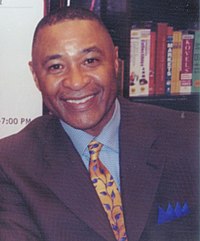
Ozzie Smith has won 13 Gold Glove Awards at shortstop, tying him for the third-highest total among winners at all positions.
The Rawlings Gold Glove Award, usually referred to as the Gold Glove, is the award given annually to the Major League Baseball players judged to have exhibited superior individual fielding performances at each fielding position in both the National League (NL) and the American League (AL), as voted by the managers and coaches in each league. Managers are not permitted to vote for their own players. Eighteen Gold Gloves are awarded each year (with the exception of 1957, 1985, 2007, and 2018), one at each of the nine positions in each league. In 1957, the baseball glove manufacturer Rawlings created the Gold Glove Award to commemorate the best fielding performance at each position. The award was created from a glove made from gold lamé-tanned leather and affixed to a walnut base. Initially, only one Gold Glove per position was awarded to the top fielder at each position in the entire league; however, separate awards were given for the National and American Leagues beginning in 1958.
Ozzie Smith, known as "the Wizard of Oz", has won the most Gold Glove Awards at shortstop; he captured 13 awards in his 19 seasons with the St. Louis Cardinals. Omar Vizquel is second among shortstops with 11 wins; he won two with the San Francisco Giants in the National League after winning nine with the Seattle Mariners and the Cleveland Indians in the American League. Luis Aparicio won nine times at shortstop for the third-highest total, followed by Mark Belanger with eight wins. Dave Concepción and Derek Jeter have won five awards; four-time winners at shortstop include Brandon Crawford, Tony Fernández, Jimmy Rollins, Andrelton Simmons and Alan Trammell. Hall of Famers who have won Gold Glove Awards at shortstop include Smith, Aparicio, Trammell, Ernie Banks, Robin Yount, Barry Larkin and Cal Ripken Jr., whose 2,632 consecutive games played earned him his "Iron Man" nickname. (Full article...) -
Image 14

The New York Yankees are a Major League Baseball (MLB) franchise based in The Bronx, New York City, New York. They play in the American League East division. This list consists of the owners, general managers (GMs) and other executives of the Yankees. The GM controls player transactions, hires the manager and coaching staff, and negotiates with players and agents regarding contracts.
The longest-tenured general manager in team history is Brian Cashman, who serves in that role for 26 years and counting. The longest-tenured owner in team history is George Steinbrenner, who was the team's principal owner from 1973 until his death in 2010. (Full article...) -
Image 15
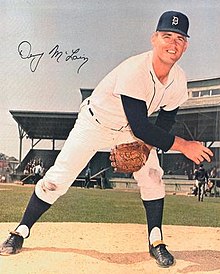
Dennis McLain, 1968 American League wins leader, with 31; this was the last time a pitcher has won thirty.
Major League Baseball recognizes the player or players in each league[a] with the most wins each season.[b] In baseball, wins are a statistic used to evaluate pitchers. Credit for a win is given by the official scorer to the pitcher whose team takes and maintains the lead while he is the pitcher of record. If a game is tied or if the lead changes to the other team, all pitchers who have participated and exited the game to that point are unable to receive credit for the victory. A starting pitcher is ineligible for the win unless he pitches at least five innings. (If he doesn't, but nevertheless leaves his team with a lead that it never relinquishes (a rather uncommon combination), the scorer would award the victory to the relief pitcher who was "most effective... in the official scorer's judgment".) (Full article...)
More did you know
- ... that umpire Bill Hohn once fist-bumped a player following the conclusion of a game?
- ... that Andy Dirks gained celebrity status in the Dominican Republic due to his performance in the Dominican Winter League's postseason?
- ... that baseball pitcher Darin Downs had to regain the ability to speak after being hit in the head by a batted ball?
- ... that President Barack Obama called to congratulate baseball pitcher Mark Buehrle after his perfect game?
- ... that Jean Segura stole first base?
Sports portals
Selected picture

| Credit: Keith Allison |
Donald Zackary "Zack" Greinke (/ˈɡrɪŋki/ GRING-kee; born October 21, 1983 in Orlando, Florida) is a Major League Baseball starting pitcher for the Kansas City Royals.
Associated Wikimedia
The following Wikimedia Foundation sister projects provide more on this subject:
-
Commons
Free media repository -
Wikibooks
Free textbooks and manuals -
Wikidata
Free knowledge base -
Wikinews
Free-content news -
Wikiquote
Collection of quotations -
Wikisource
Free-content library -
Wikiversity
Free learning tools -
Wiktionary
Dictionary and thesaurus
More portals
- Pages with Spanish IPA
- Pages with Catalan IPA
- Portals with triaged subpages from June 2018
- All portals with triaged subpages
- Portals with no named maintainer
- Automated article-slideshow portals with 51–100 articles in article list
- Automated article-slideshow portals with 501–1000 articles in article list
- Random portal component with 41–50 available subpages
- Automated article-slideshow portals with 201–500 articles in article list
- Random portal component with 11–15 available subpages
- Random portal component with 21–25 available image subpages







